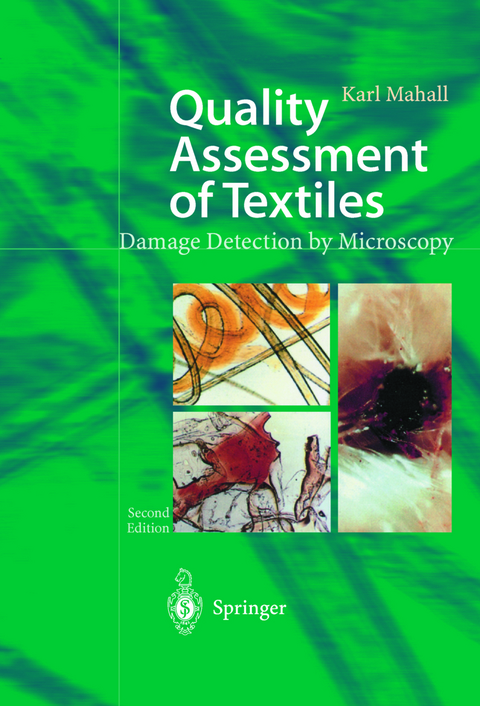
Quality Assessment of Textiles
Springer Berlin (Verlag)
978-3-642-62893-1 (ISBN)
1 Fundamentals and Priming.- 1.1 Necessary Equipment.- 1.2 Preliminary Examination of Textile Test Material.- 1.3 Classical Examination Methods.- 1.4 Preparation of Negative Imprints with the Size of Microscope Slides.- 1.5 Preparation of Negative Imprints of Fibers and Yarns on Thermoplastic Films.- 1.6 Imprints of Larger Areas.- 1.7 Microtome Sections.- 2 Chemical Damage.- 2.1 Chemical Damage to Wool.- 2.2 Chemical Damage to Silk.- 2.3 Chemical Damage to Cotton.- 2.4 Chemical Damage to Synthetics.- 3 Mechanical Damage.- 3.1 Mechanical Damage to Wool.- 3.2 Mechanical Damage to Silk.- 3.3 Mechanical Damage to Cotton.- 3.4 Mechanical Damage to Cellulose Regenerated Fibers Graying During Dyeing on the Winch - Practical Example.- 3.5 Mechanical Damage to Synthetic Fibers.- 4 Thermal and Thermo-Mechanical Damage to Synthetics.- 4.1 Thermal Damage Caused by Direct Heat.- 4.2 Thermal Deformation of Synthetic Fibers Due to Frictional Heat.- 4.3 Thermal Damage to Synthetic Fibers due to Impact.- 4.4 Thermal Deformation of Synthetic Fibers Due to Cutting, Punching and Sewing.- 5 Streaks and Bars in Textile Fabrics Due to Yarn Differences and Technological Reasons.- 5.1 Streaks Due to Variations in the Yarn Volume or Yarn Count.- 5.2 Streaks and Bars Parallel to Threads Due to Yarn Mixture Errors.- 5.3 Streak and Bar Formation Due to Other Yarn-Related Influences.- 5.4 Streaks in Pile Goods.- 6 Causes of the Formation of Tight Threads and Their Effects.- 6.1 Tight Threads in Wool Fabrics Caused by Uneven Yarn Moisture.- 6.2 Tight Picks in a Fabric Made of Viscose-Practical Example.- 6.3 Tight Threads Caused by Different Yarn Twist - Practical Example.- 7 Defects Caused by Deposits and Encrustations on the Fiber Material.- 7.1 Detection of Oil, Grease, Paraffin or Wax Depositsby Means of Dyeing with Oil-Soluble Dyes.- 7.2 Detection of Oil, Grease, Wax and Paraffin Deposits by Means of Film Imprints.- 7.3 Detection ofPigment Deposits on Imprints.- 7.4 Detection of Film-Forming Products and Film-Like Deposits by Means of Imprints.- 7.3 Detection ofPigment Deposits onImprints.- 7.5 Detection of Deposits in Staining Tests, Yarn Cross-Sections and/or Fabric Cross-Sections.- 8 Other Defects in the Quality of Textiles.- 8.1 Skittery Dyed Wool Yarn - Practical Example.- 8.2 Uneven Wool Printing - Practical Example.- 8.3 Small Light Spots Caused by Trapped Air Bubbles During the Dyeing of Wound Packages.- 8.4 Dye Unlevelness in Polyester Knitwear Caused by Water Drops - Practical Example.- 8.5 Dye Unlevelness Within a Spinning Lot Due to Separation of the Fiber Components - Practical Example.- 8.6 Darker Specks of Dyed Feather Bed Ticking Due to Non-Decomposed Seed Husks - Practical Example.- 8.7 Spots Due to Dark-Dyed Fly Fibers - Practical Example.- 8.8 Red Specks Due to Dyed, Melted and Flat-Rolled Man-Made Fly Fibers on a White Viscose Staple Fabric.- 8.9 Light, Undyed Short Bristly Fibers in a Wool Yarn - Practical Example.- 8.10 Gray, Dot-Like Stains on Needlefelt Sheets - Practical Example.- 8.11 Running Marks in a Cotton Tricot Fabric - Practical Example.- 8.12 Shade Differences in Dress Fabrics Due to Different Hairiness - Practical Example.- 8.13 Brittle, Dope-Dyed Acrylic Fiber Material on the Carding Machine and Drawing Frames - Practical Example.- 8.14 Light Specks in a Milled Terry Towelling Fabric Due to Dead Cotton - Practical Example.- 8.15 Bonded Yarns in a Cotton Cross-Wound Bobbin - Practical Example.- 8.16 Knitted Goods Sticking Together in Garment Production Due to Hairiness of Cotton Yarn -Practical Example.- 8.17 Cotton Fabrics With Side-to-Center Shading Due to Uneven Squeezing Effects - Practical Example.- 9 Microbiological Damage to Fibers.- 9.1 Damage Caused by Fungi.- 9.2 Damage Caused by Bacteria.- 10 Poultry Feathers as Filling Material for Bedding and Textiles - Analysis of Faults.- 10.1 Chemical and morphological structure of poultry feathers.- 10.2 Detection of damage to poultry feathers.- References.- Figures.- Appendix: Technical Equipment, Chemicals, Reagents and Dyes (with new substitutes/suppliers) for Microscopic Damage Analysis.
From the reviews:
"This concisely written, very practical book, goes very much to the point in assisting its readers in assessing the root causes of problems in textile fabrics. ... This book is well-written, systematically organized, and appropriately referenced ... . for those involved with fabric development, use, and testing, this book will be a valuable reference." (David, Schiraldi, Polymer News, Vol. 29 (1), 2004)
| Erscheint lt. Verlag | 24.10.2012 |
|---|---|
| Zusatzinfo | XXI, 238 p. |
| Verlagsort | Berlin |
| Sprache | englisch |
| Maße | 170 x 242 mm |
| Gewicht | 461 g |
| Themenwelt | Naturwissenschaften ► Chemie ► Organische Chemie |
| Technik ► Maschinenbau | |
| Schlagworte | Chemistry • Faserstoff • Fibre • Qualitätsbeurteilung • Quality Assessment • Textil-Chemie • Textile • Textile chemistry • textile engineering • Textile Finishing • textile fisnishing • textile processing • Textiles • Textilien • Textiltechnik • Textilveredelung |
| ISBN-10 | 3-642-62893-1 / 3642628931 |
| ISBN-13 | 978-3-642-62893-1 / 9783642628931 |
| Zustand | Neuware |
| Haben Sie eine Frage zum Produkt? |
aus dem Bereich


